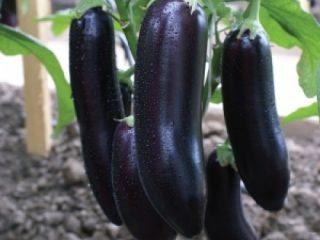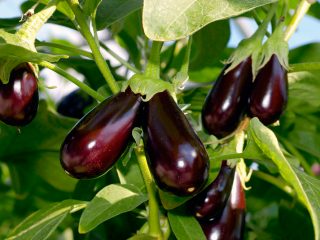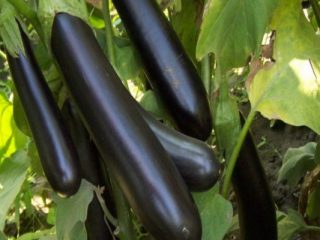Content
Eggplant is a wonderful vegetable, tasty, healthy and amazingly beautiful. The variety of taste, shape, color and aromas is amazing in its diversity. But many summer residents refuse to grow eggplants themselves, preferring to buy them at the market. This is explained by some “difficulties” when growing crops. In fact, growing “little blue ones” has its own rules. If you follow the recommendations, then the gratitude of eggplant will justify all the efforts.
Experienced gardeners believe that only the seedling method of growing eggplants ensures a decent harvest. Many people buy ready-made seedlings, but the majority of vegetable lovers grow their own.
After all, it’s not always possible to find the variety that caught your attention. Therefore, let’s look at the main nuances of the technology growing eggplant seedlings.
Stage one - select eggplant seeds for seedlings
Selecting seeds is not only exciting, but also a very important activity for eggplant lovers. You need to determine which type of eggplant you will prefer - varietal or hybrid.If you are not going to harvest seeds for next year from your garden, then hybrids are quite suitable. And when you want to save your favorite vegetable from the garden, it is better to buy a regular varietal eggplant for seedlings.
Hybrid seeds are of higher quality, but do not have the ability to retain their parameters for the next planting year. But ordinary seeds will pass on all the characteristics to their offspring. The choice is yours.
The abundance of varieties is encouraging, but you should adhere to the basic rules for choosing seed material. You need to pay attention to the following parameters:
- Productivity. High-yielding species are usually more demanding on growing conditions. Therefore, clearly find out what conditions the variety and its seedlings need. If you can always provide watering, mulching or nutrition, you will not be able to radically change the composition of the soil. A low-yielding variety is less demanding, easier to care for, and in the end may turn out to be more productive than its high-yielding counterpart.
- Endurance. This parameter means the plant’s resistance to climatic changes, diseases, pests and violations of agricultural technology requirements. This will also have to be taken into account because in recent years abnormal weather events and climate changes in the regions have become more frequent. Choose resistant varieties with a smaller list of beneficial properties. They will be more adaptable.
- Keeping quality. This is also not the last criterion for eggplants grown through seedlings. Some species are able to survive for a long time without losing their nutritional qualities.
Another important criterion that must be taken into account when choosing an eggplant variety for seedlings is compliance with the cultivation zone or zoning.Such eggplant seeds, planted as seedlings, will give a guaranteed harvest.
In conclusion, carefully read the description of the variety, the name of the manufacturer, and carefully read the reviews of summer residents.
Stage two - determine the sowing date
Question "When to plant eggplants for seedlings?”, not at all idle. Many indicators depend on the chosen time, including eggplant yield. Summer residents use simple calculations and recommendations from the lunar sowing calendar. The countdown is made from the date of planting of seedlings for permanent residence.
We are counting on when to plant eggplant seedlings in 2024. The lunar calendar allows you to find out when planting eggplant seedlings will be most successful.
Favorable and unfavorable days for planting eggplants in 2024:
Eggplants are heat-loving vegetables; cold is unpleasant to them. Therefore, we will take May 10, 2024 as the calculation date. Let's keep counting. Seedlings are planted at the age of 65-70 days. We subtract this number from the date May 10, we get the beginning of March (from 1 to 6). It is also necessary to subtract the period during which the first shoots appear (from 5 to 10) and we get February days from 19 to 24.
If in the region where you live, the threat of frost passes later, then the calculation is made taking this indicator into account. Select the desired disembarkation date and count back all the listed dates.
Let's start sowing seeds
First of all, let’s prepare containers and soil mixture so that the seeds have somewhere to plant.
The soil requirements for eggplant seedlings are:
- fertility;
- ease;
- looseness;
- neutrality in acid level.
To provide the soil with all these parameters, we prepare the mixture in percentage composition:
- peat - 60;
- turf land - 10;
- humus - 20;
- sawdust or sand - 5;
- vermicompost - 5.
Another suitable option for summer residents with black soil on their plot is equal parts of soil from the garden, purchased soil for seedlings, and sand. By adding vermiculite, you will ensure excellent results.
The next step will be to prepare the planting containers. Here the imagination of gardeners knows no bounds. In addition to ordinary cups and pots, peat tablets, cassettes, laminate backing, and toilet paper are used. Each method is good in its own way, but they all have their drawbacks.
Preparing the seeds eggplants for sowing. If you have processed seed material, then there is no need for preparation. Regular seeds need to be processed independently:
- soak in a solution of potassium permanganate for 30 minutes;
- rinse with water;
- place in a nutrient solution for a day (for 1 liter of water, 1 spoon of wood ash and mineral fertilizer);
- transfer eggplant seeds to germinate.
They improve the germination and frost resistance of seeds for seedlings by hardening. To do this, move the seed material several times after the nutrient mixture into the refrigerator and back into the room. At this time, the seeds should be moderately moist and then immediately planted in the soil mixture.
Place one seed in each container filled with moistened soil. There are recommendations to moisten the soil mixture for eggplant seedlings with melted snow.
The results meet the expectations of gardeners.
Raising healthy seedlings
Caring for seedlings is not difficult, but requires fulfillment of all points. The most important of them:
Temperature
After the seeds fall into the ground, the container must be covered with polyethylene. But as soon as the sprouts appear, it is important to reduce the air temperature so that the root system of eggplant seedlings develops well.
It is optimal to keep +17° during the day and +14° at night. After the first leaves appear, the temperature is increased. The daytime reading is +25°, at night we leave it the same. This is necessary to prepare the seedlings for open ground conditions.
Lighting
Seedlings really need light, although eggplant is considered a short-day plant. If you provide artificial light for 12 hours, this will be enough for the first three weeks. Then they add additional lighting so that the sprouts do not stretch out and the eggplant budding phase begins earlier.
Watering
Water for irrigation is taken at room temperature. It is better to use a spray bottle to moisten. This way, you will avoid washing out the eggplant seeds and not damage the roots of the seedlings. Drying out the soil is extremely undesirable for eggplant seedlings, so monitor its moisture. Water is used from rainwater or standing water for 24 hours.
Feeding
Not all summer residents feed eggplant seedlings. But if the need arises, the nutrition schedule will be like this:
- First. Without picking seedlings a week after sprouts appear. With picking 12 days after planting. Use compositions with a high percentage of phosphorus (Yellow Crystal) in a ratio of 1 tbsp. spoon of fertilizer per 10 liters of water.
- Subsequent. Do this at intervals of a week to stimulate vegetation (Special Crystal).
Picking seedlings
Let's move on to a process that seems difficult for beginners. Eggplant seedlings do not like transfers. These are delicate plants that are difficult to tolerate stress and damage to the root system. Therefore, at this stage, care and caution are required. We perform a number of actions:
- 3 hours before picking, water the seedlings;
- fill larger containers with nutritious soil mixture;
- moisten the soil;
- We place the seedlings in the recesses, immersing them down to the first leaves.
Caring for pickled eggplant seedlings will consist of:
- combination of fertilizing with watering;
- monthly addition of wood ash;
- watering at a certain time - in the morning;
- hardening of seedlings.
Before planting, eggplant seedlings must have up to 12 true leaves, be healthy and strong, up to 25 cm in height.
We plant seedlings for permanent residence
In our case, it could be a greenhouse or a vegetable garden. For one square meter of greenhouse planting site, a mixture of magnesium sulfate (15 g), humus (4 kg), potassium sulfate and ammonium nitrate (30 g each), superphosphate (60 g) is prepared. The components are mixed and the mixture is applied to the soil. Before planting, prepare the holes and transplant eggplant seedlings with a lump of earth into them. The seedling planting depth is 8 cm. If the lump crumbles, then it is strengthened with a mash of mullein and clay. The distance between eggplants is 50 cm, row spacing is maintained up to 1 m.
Planting density – three eggplants per 1 sq. m area. The soil is sprayed and shade is created for the seedlings. This must be maintained until the eggplant seedlings get used to sunlight.
Planting in open ground is carried out in the evening, then the sprouts are covered with film or paper caps.
Caring for planted eggplant seedlings involves timely:
- feeding;
- watering;
- hilling.
Some gardeners form eggplant bushes in greenhouses.
Unusual ways to grow eggplant seedlings
Recently, gardeners have been using new ways to grow vegetable seedlings. A new technology has gained popularity when eggplant seedlings are sown in a snail.
In this method, the seeds are placed on a strip of laminate backing. The optimal dimensions of the strip are 10 cm x 1.5 m. The strip is laid out, soil is poured in and seeds are placed at a distance of 2 cm.
The strip is twisted, secured with an elastic band and placed in a plastic container. Water and cover immediately to maintain optimal humidity. A video with detailed explanations will help you get acquainted with the technology:
Every gardener can grow eggplant seedlings. To ensure that the whole process occurs without errors, try to think through your actions in advance. If necessary, write it down. This will make it easier and faster to grow eggplant seedlings.
Video on sowing seeds for seedlings:
















